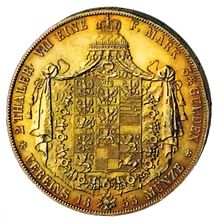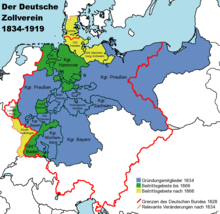Dresden Coin Agreement
The Dresden Mint Agreement of July 30, 1838 linked the members of the South German Mint Association , linked by the Munich Mint Agreement of August 25, 1837, with some northern German states under the umbrella of the German Customs Association .
Member states
Initially, all customs union states joined the Dresden Treaty. Founding members were: 1. for the Taler area: Prussia, Saxony, Electorate of Hesse (Hessen-Kassel), Grand Duchy of Saxony (Saxony-Weimar-Eisenach), Saxony-Altenburg, Saxony-Coburg-Gotha, Schwarzburg-Rudolstadt (only for the subordinate rule) , Schwarzburg-Sondershausen, Reuss (older and younger lines); 2. for the Gulden area: Bavaria, Württemberg, Baden, Grand Duchy of Hesse (Hessen-Darmstadt), Saxe-Meiningen, Saxe-Coburg-Gotha (only for the Principality of Coburg, otherwise Taler area), Nassau, Schwarzburg-Rudolstadt (only for sovereignty ), Frankfurt. The contract was subsequently joined by: Oldenburg (only for the Birkenfeld region), the Anhalt and Waldeck lines (each for the Taler area). Not joined: Braunschweig, Bremen, Hamburg, Hanover, Lübeck, both Mecklenburg, Oldenburg for the home country, Schleswig and Holstein, Lauenburg and Austria. The non-acceding states also did not become members of the Zollverein.
Essential content of the contract
Among the key points of the contract: the determination of the Münzgrundgewichtes of Cologne Mark exactly 233.855 grams, the monetary standard at 14 dollars and 24 1 / 2 guilders. The North German taler of the 14 thaler foot and the gulden of the South German Mint Association were thus set in a fixed relationship to one another. The thaler thus corresponded to 1.75 guilders. 30 silver groschen of the thaler area (1 thaler = 30 silver groschen) thus corresponded to 45 kreuzers in the gulden area (1 gulden = 60 kreuzers). These relationships were now fixed and therefore clearer than before.
After the Munich Coinage in the southern German area a year before the 24 1 / 2 - Gulden -foot as Silver Standard introduces binding and the fractional coins down to the 3- cruiser had set -Stück using uniform weights and measures, so that was the connection of the South German Gulden monetary standard to the Prussian 14 thaler foot, which z. As well as in the Kingdom of Saxony under responsibility of the previous 13 1 / 3 - Convention Taler was introduced -Fußes completed. Symbolizing the contract was the new big silver coin worth 2 Taler or 3 1 / 2 Gulden, as everywhere valid club coin decided and physically in the following years when, minted in very small extent.
The series of the three most important minting agreements of the German Customs Union was concluded with the Vienna Mint Treaty of January 24, 1857 with the introduction of simple club thalers, which were now recognized as official union thalers as uniform Kurant coins in all customs union countries - including the southern German guilder countries and Austria . At the same time, the transition from the weight mark (= 16 lot ) to the inch pound (= 30 new lot = 500 grams ) as a precious metal weight for the coin base took place . It was:
- 1 pound of fine silver = 30 club thalers
The fine silver content of the taler hardly changed. It fell from a theoretical 16.704 to 16.667 grams. The small difference did not lead to any different treatment of the thalers minted before and after the Vienna Treaty by payment transactions.
Effects
For a long time, the Dresden Mint Treaty was considered to be the decisive preparation for the Imperial Coin Laws of 1871 and 1873. Only recently has its importance been relativized. The Prussian coin reform of 1821, which was a pure reform of the Prussian small coin system, the Munich coin agreement of 1837 and the Saxon coin reform of 1840 are now considered to be at least equivalent to the Dresden coin agreement. The Munich Coin Treaty had already anticipated all the essential parameters for standardizing the basic weight of coins and for harmonizing the coin feet of the Taler and Gulden areas, as the South German Mint Association had adequately adapted itself to the Prussian circumstances. The Dresden Mint Treaty only continued the essential stipulations of the Munich Mint Treaty. It brought little new content, but was of great symbolic importance.
Individual evidence
- ^ Hermann Junghans: Developments and convergences in the coinage of the German states between 1806 and 1873 with special consideration of the small coins (= contributions to economic and social history, volume 131). Franz Steiner Verlag, Stuttgart 2017, pp. 15–17, 399–402.


